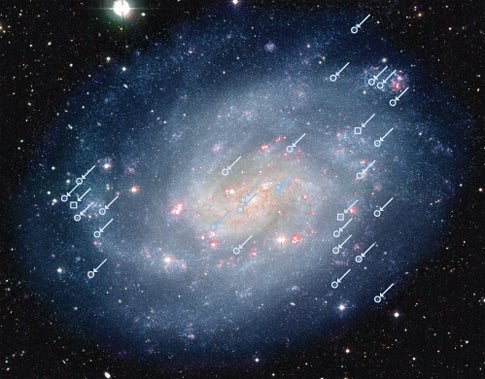Astronomers have discovered a new method used to measure extragalactic distances accurately based on the stellar gravities and effective temperatures of blue supergiant stars in galaxies beyond the Local Group. The paper will be presented at the meeting of the American Astronomical Society (AAS) in Honolulu.
Rolf-Peter Kudritzki of the Institute for Astronomy (IfA) and his collaborators observed the galaxy NGC 300, which is about 6 million light-years away and located in the constellation Sculptor, to test this new method of measuring distances between galaxies. They took spectra to measure the atmospheric temperature of the stars and their surface gravity. With these measurements, they were able to determine the intrinsic brightness of each star and then to compare the apparent brightness with intrinsic brightness to find the distance.
They then compared their distance measurements to those made using Cepheid variable stars, the traditional way to measure the distance to nearby galaxies. “This new method works excitingly well,” says Kudritzki. “It seems that we can determine distances to other galaxies with an accuracy of five percent, which opens a complementary way to constrain the Hubble constant more precisely.” The Hubble constant denotes the current rate of expansion of the universe.
Their observations consisted of medium- and low-resolution spectra taken with the Focal Reducer Spectrograph (FORS) on the European Southern Observatory’s Very Large Telescope in Paranal, Chile. Kudritzki was instrumental in designing FORS while at the University of Munich before coming to Hawaii in 2000. In its most recent work on other galaxies, the project team has also used the Low Resolution Imaging Spectrometer (LRIS) on the Keck I telescope at Mauna Kea Observatories in Hawaii. Both FORS and LRIS are very efficient spectrographs, which allows the team to take spectra of many stars in a galaxy simultaneously (in a single exposure). These stars can then be studied individually later, when the data are analyzed to determine atmospheric temperatures and surface gravities.
The talk at the AAS meeting will describe their analysis method. It will also discuss the determination of the chemical composition of the individual stars in distant galaxies and how the chemical composition changes from the center of the galaxies to their outskirts.
Blue supergiant stars are the largest and brightest stars in the universe at visual wavelengths, with an intrinsic brightness between 10,000 and 1000,000 times that of the sun. They appear blue in color because the temperature of their atmospheres is 150 percent to 500 percent times than that of the sun. Because of their blue color and their enormous brightness, they stand out among the hundred billion stars in a galaxy, and so are easy to find and identify. This makes them ideal for studying stellar populations in galaxies beyond the Local Group (the group of galaxies that contains our own Milky Way galaxy) to learn about distances, chemical composition, star formation in galaxies, and the absorption of starlight by gas and dust between stars. In the Milky Way, Deneb in the constellation Cygnus the Swan and Rigel in Orion are two well-known blue supergiants.










